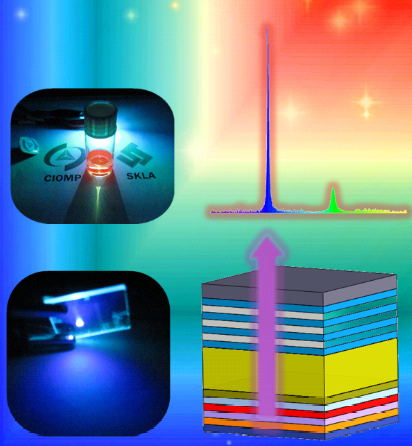
Microcavity organic light-emitting diodes (MOLEDs) have the advantages such as emission wavelength tunability and narrow linewidth. However, due to the wide intrinsic spectrum of organic materials, it is difficult to regulate spectral linewidth to an ideal value using a conventional half-wavelength microcavity design, and to balance the contradiction between optical design and electrical characteristic by increasing the thickness of the functional layer.
Therefore, it is necessary to develop a new type of narrow linewidth MOLED through a novel structural design to promote the advancement of advanced monochromatic light sources with promising applications.
In a study published in Advanced Optical Materials, a research group led by Prof. LIU Xingyuan from Changchun Institute of Optics, Fine Mechanics and Physics (CIOMP) of the Chinese Academy of Sciences realized a narrow linewidth MOLED with non-quarterwave structural design.
This novel MOLED with wavelength tunable and structure adjustable was constructed by using a new type of distributed Bragg reflector (DBR) with low absorption spacer as a bottom mirror. The role of spacer is to precisely regulate the length of the cavity to meet the resonance conditions of microcavity.
By using DBRs with different structural design, the researchers investigated different factors such as pairs, reflectivity and thickness of spacer, which affect the electroluminescence (EL) properties of microcavity. According to the resonance principle of microcavity, the number of modes in the cavity is enhanced by increasing the pairs of the DBR and the thickness of the spacer, so as to narrow the spectral linewidth significantly.
As a result, a novel MOLED with optimized structural design and narrow linewidth (2 nm) was realized under the premise of almost not changing the electrical injection of the functional layer materials in the cavity, thereby achieving a balance between optical design and electrical characteristic.
Compared with the currently employed in lighting and display systems, MOLEDs in the future likely involve new materials and applications, and will be a promising competitor to conventional OLEDs.
This study demonstrated a general applicability of a novel design strategy to obtain high-quality monochromatic light, which is suitable for regulating the color purity for emitters with a large full width at half maximum (FWHM) such as emitters relying on organic materials, colloidal quantum dots (QD) and perovskite materials.

Narrow linewidth blue MOLED based on non-quarterwave structural design. (Image by Prof. LIU’s Group)

86-10-68597521 (day)
86-10-68597289 (night)

86-10-68511095 (day)
86-10-68512458 (night)

cas_en@cas.cn

52 Sanlihe Rd., Xicheng District,
Beijing, China (100864)

